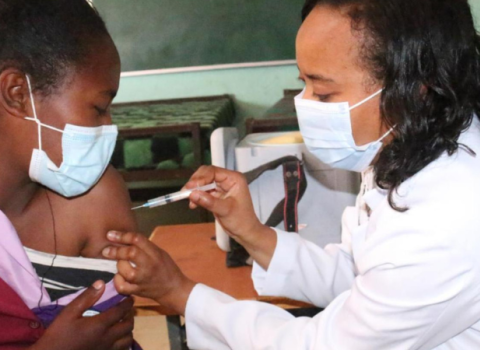It is time to drop euphemisms like DNA medicines and gene-based medicines: gene therapy has made it through to the commercial mainstream.
More than 17 years after the first (supposedly) successful treatment was publicised, a big-ticket, big-pharma deal was signed for a gene therapy product last week, when Sanofi-Aventis agreed a €518 million licence for Oxford BioMedica plc’s TroVax, a cancer treatment.
Related article
Companies make strides to market in gene therapy [subscription required]
Acknowledge it for what it is
But first the industry will have to drop all the alternative nomenclature it has adopted as cover over the past decade when the field was getting a bad press, and acknowledge gene therapy for what it is, and for what it entails.
Gene therapy became headline news in 1990 when two girls with severe combined immune deficiency disease (SCID) recovered after the gene for adenosine deaminase, the enzyme they were unable to generate naturally, was administered.
This led to the rampant development of the field and within five years over 100 gene therapy trials were approved in the US. But then in September 1999, 18-year-old Jesse Gelsinger, a patient at the University of Pennsylvania’s Institute of Human Gene Therapy in Philadelphia with a mild form of a rare genetic liver disease, died following treatment as part of a study assessing safety.
In the investigation that followed allegations were made of deaths in other gene therapy trials, and a number of studies were suspended by the US Food and Drug Administration.
The fall from grace
Inevitably, this kick started gene therapy’s fall from grace, leading alternative labels to be adopted. But work continued in the background to overcome safety issues and develop scalable products. In the past decade gene therapy has moved from academic research into established commercial development and there are diverse products in clinical trials.
According to figures published by the Journal of Gene Medicine in January 2007, there are 1,260 gene therapy clinical trials in progress. Of these, 27 have reached Phase III and 13 Phase II/III, showing that a number of products are edging close to market.
The gene therapy paradigm has evolved since the original concept of using introduced genes to replace ones that are defective or missing. Products in development are delivering a range of genes, with a range of therapeutic objectives.
This evolution of the technology means that treating inherited gene defects is no longer the leading objective. Of the 1,260 gene therapy trials currently in progress, 67 percent are in cancer, while inherited single gene defects account for 8.4 percent.
The benefits are there
The trials have shown that gene therapy can provide significant clinical benefits with good safety profiles in hitherto difficult, or impossible, to treat diseases. TroVax, for example, has been in nine studies involving more than 180 patients. There have been no serious adverse events and more than 90 per cent of patients mounted an immune response. This has resulted in high levels of tumour shrinkage and indications of survival benefit, with a correlation between the level of clinical benefit and the strength of the immune response.
While the deal between Oxford BioMedica and Sanofi is important in giving gene therapy the big pharma stamp of approval, Ark Therapeutics Group plc looks likely to win the race to be the first company to get approval for a gene therapy treatment in a western market. Its treatment for glioma was accepted for review by the European regulator EMEA in 2005 on the basis of two Phase II trials, with the verdict expected any time now.
Currently, the only marketed gene therapy is Gendicine, developed by SiBiona GeneTech Co Ltd of Shenzhen, China, which was approved in October 2003 for the treatment of head and neck cancer.
As with all novel medicines, gene therapy has had a long and convoluted journey to reach this validation.
Where's the ripple?
Strange then, that news of gene therapy’s imminent breakthrough to commercial reality has caused hardly a ripple. Indeed, while he must be feeling rather pleased to have brought 18 months of partnering negotiations to a successful conclusion, the CEO of Oxford-based Oxford BioMedica, Alan Kingsman was no doubt bemused to see the company’s share price fall 2.5 pence to 49.5 pence on 28 March when the deal with Sanofi was announced.
Companies in the field are partly to blame if they are not getting the recognition they so obviously deserve. Nigel Parker, CEO of Ark Therapeutics, was disappointed at the scant understanding of the London-based company’s achievement in getting Cerepro accepted for review. But he also acknowledged Ark had deliberately distanced itself from the gene therapy label.
In the face of negative publicity most companies working in the area have dissembled, adopting the term DNA medicines, or camouflaging their products with labels such as DNA vaccine, cancer vaccine or cancer immunotherapy.
Now though, there is a resounding clinical and commercial endorsement, and this should be something for the industry to celebrate. So no more euphemisms: TroVax uses a viral vector to deliver the gene for 5T4, an antigen that occurs on the surface of solid tumours.
There’s no need to be squeamish any more – this is gene therapy. The term should be allowed back into the lexicon and all those involved in developing gene therapies should stand up and say “This is what we do”.






 A unique international forum for public research organisations and companies to connect their external engagement with strategic interests around their R&D system.
A unique international forum for public research organisations and companies to connect their external engagement with strategic interests around their R&D system.